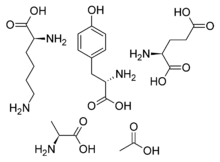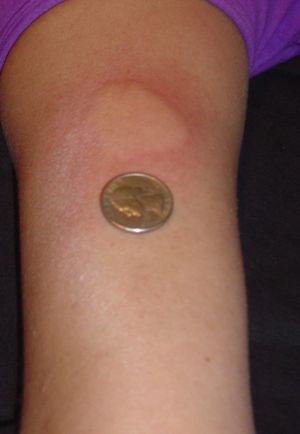- Glatiramer acetate
-
Glatiramer acetate 
Systematic (IUPAC) name acetic acid; (2S)-2-amino-3-(4-hydroxyphenyl)propanoic acid; (2S)-2-aminopentanedioic acid; (2S)-2-aminopropanoic acid; (2S)-2,6-diaminohexanoic acid Clinical data AHFS/Drugs.com monograph Pregnancy cat. ? Legal status ? Identifiers CAS number 147245-92-9 
ATC code L03AX13 PubChem CID 3081884 DrugBank APRD00999 UNII 5M691HL4BO 
ChEMBL CHEMBL1201507 
Chemical data Formula C25H45N5O13 Mol. mass 623.65 g/mol  (what is this?) acetate (verify)
(what is this?) acetate (verify)Glatiramer acetate (also known as Copolymer 1, Cop-1, or Copaxone - as marketed by Teva Pharmaceuticals) is an immunomodulator drug currently used to treat multiple sclerosis. It is a random polymer of four amino acids found in myelin basic protein, namely glutamic acid, lysine, alanine, and tyrosine, and may work as a decoy for the immune system. Glatiramer acetate is approved by the FDA for reducing the frequency of relapses, but not for reducing the progression of disability. Observational studies, but not randomized controlled trials, suggest that it may reduce progression of disability.
Although the clinical definition of multiple sclerosis requires two or more episodes of symptoms and signs, glatiramer acetate is approved for treatment after single episodes. It is also used to treat relapsing-remitting multiple sclerosis. It is administered by subcutaneous injection.
Contents
Mechanism of action
Glatiramer acetate is a random polymer (average molecular mass 6.4 kD) composed of four amino acids that are found in myelin basic protein. The mechanism of action for glatiramer is unknown, although several have been proposed. Administration of glatiramer shifts the population of T cells from pro-inflammatory Th1 cells to regulatory Th2 cells that suppress the inflammatory response.[1] Given its resemblance to myelin basic protein, glatiramer may also act as a sort of decoy, diverting an autoimmune response against myelin. The integrity of the blood-brain barrier, however, is not appreciably affected by glatiramer, at least not in the early stages of treatment. Glatiramer acetate has been shown in clinical trials to reduce the number and severity of exacerbations.[2]
The mechanism(s) by which glatiramer acetate exerts its effects in patients with Multiple Sclerosis (MS) is (are) not fully elucidated. However, it is thought to act by modifying immune processes that are currently believed to be responsible for the pathogenesis of MS. This hypothesis is supported by findings of studies that have been carried out to explore the pathogenesis of experimental autoimmune encephalomyelitis (EAE), a condition induced in several animal species through immunization against central nervous system derived material containing myelin and often used as an experimental animal model of MS. Studies in animals and in vitro systems suggest that upon its administration, glatiramer acetate-specific suppressor T-cells are induced and activated in the periphery.[3]
Effectiveness
A 2004 Cochrane review[4] concluded that Glatiramer acetate "did not show any beneficial effect on the main outcome measures in MS, i.e. disease progression, and it does not substantially affect the risk of clinical relapses."
In its pivotal trial of 251 patients, after 2 years Copaxone failed to show any advantage in halting disability progression.[5][6]
As a result, Copaxane is approved by the FDA for reducing the frequency of relapses, but not for reducing the progression of disability.[7]
A 15-year followup of the original trial compared patients who continued with glatiramir to patients who dropped out of the trial. Patients with glatiramer had reduced relapse rates, and decreased disability progression and transition to secondary progressive MS, compared to patients who did not continue glatiramer. However, the two groups were not necessarily comparable, as it was no longer a randomized trial. There were no long-term safety issues.[8]
In 2 recent studies, both reported at the 2007 ECTRIMS meeting, the efficacy of glatiramer acetate was compared to high-dose/high-frequency interferon beta. In the REGARD study[citation needed], Rebif was compared to glatiramer, and in the BEYOND study[citation needed], Betaseron was compared to glatiramer. In both trials, there was no significant difference between interferon and glatiramer in the primary endpoints (time to relapse) or in any clinical endpoints, although some differences in MRI measures of disease activity have been claimed.
A double-blind 3-year study found no effect of glatiramer acetate on Primary-Progressive Multiple Sclerosis.[9]
Copaxone has FDA approval for clinically isolated syndrome, based on the PreCISe trial, which showed that glatiramer delayed the progression from the first clinical event to clinically definite multiple sclerosis with a risk reduction of 45%. 43% of patients in the placebo group converted, compared to 25% in the glatiramer group.[10]
Development
Glatiramer acetate was originally discovered by Dr. Dvora Teitelbaum at the Weizmann Institute of Science in Rehovot, Israel. The efficacy and safety of glatiramer acetate were demonstrated in three main clinical trials. The first trial, led by Professor Murray Bornstein, was performed in a single center, double-blind, placebo controlled trial and included 50 patients.[citation needed] The second trial was a 2-year, multi-center, randomized, double-blind, placebo controlled trial and was performed in eleven US centers involving 251 patients. This study was led by Professor Kenneth Johnson, Chairman of the Department of Neurology, University of Maryland Medical Center, Baltimore.[citation needed] The third trial, a double-blind, multi-center, multi-country MRI study, involved 29 MS Centers in six European countries and Canada, with the participation of 239 patients. This study was led by Professor G. Comi, Department of Neuroscience, San Raffaele Hospital, the University of Milan.[citation needed]
Marketing and distribution
Glatiramer acetate has been approved for marketing in 49 countries worldwide, including the United States, Israel, Canada and 24 European Union Countries.
Approval in the US was obtained in 1996. Glatiramer acetate was approved for marketing in the U.K. in August 2000, and launched in December. This first approval in a major European market enabled Teva to file for approval all over the European Union under the mutual recognition procedure.
Side effects
According to MediGuard, side effects may include a lump at the injection site (injection site reaction) in approximately 30% of users, and aches, fever, chills (flu-like symptoms) in approximately 10% of users.[11] Copaxone is the only disease modifying drug that does not cause flu like symptoms in patients. Side effect symptoms are generally mild in nature. A reaction that involves flushing, shortness in breath, anxiety & rapid heartbeat has been reported soon after injection in up to 5% of patients (usually after injecting directly into a vein). These side effects subside within thirty minutes. Over time, a visible dent at the injection site can occur due to the local destruction of fat tissue, known as lipoatrophy, that may develop.
More serious side effects have been reported for glatiramer acetate, according to the FDA's prescribing label, these include serious side effects to the body's Cardiovascular System, Digestive System (including Liver), Hemic and Lymphatic System, Musculoskeletal System, Nervous System, Respiratory System, Special Senses (in particular the eyes), Urogenital System; also reported have been Metabolic and Nutritional Disorders; however a link between glatiramer acetate and these adverse effects has not been definitively established.[12]
Research
Glatiramer has been found to be protective in a mouse model of cerebral malaria.[13]
Glatiramer is currently in Phase I clinical trials for Dry Age-Related Macular Degeneration (AMD).
References
- ^ The chemistry of the Copaxone drug
- ^ www.mult-sclerosis.org
- ^ [1]
- ^ Cochrane Medical review of Copaxone Better citation needed
- ^ Johnson KP, Brooks BR, Cohen JA, et al. (July 1995). "Copolymer 1 reduces relapse rate and improves disability in relapsing-remitting multiple sclerosis: results of a phase III multicenter, double-blind placebo-controlled trial. The Copolymer 1 Multiple Sclerosis Study Group". Neurology 45 (7): 1268–76. PMID 7617181.
- ^ Johnson KP, Brooks BR, Cohen JA, et al. (March 1998). "Extended use of glatiramer acetate (Copaxone) is well tolerated and maintains its clinical effect on multiple sclerosis relapse rate and degree of disability. Copolymer 1 Multiple Sclerosis Study Group". Neurology 50 (3): 701–8. PMID 9521260.
- ^ Full Prescribing Information (Package insert) Label approved on 02/27/2009 (PDF) for COPAXONE, NDA no. 020622 at Drugs@FDA
- ^ [Free full text "Continuous long-term immunomodulatory therapy in relapsing multiple sclerosis : results from the 15-year analysis of the US prospective open-label study of glatiramer acetate"]. Multiple Sclerosis 16 (3): 342–50. January 27, 2010, Mar 4, 2010. doi:10.1177/1352458509358088. PMID 20106943. http://www.ncbi.nlm.nih.gov/pmc/articles/PMC2850588/ [Free full text].
- ^ Wolinsky J, Narayana P, O'Connor P et al. (2007). "Glatiramer acetate in primary progressive multiple sclerosis: results of a multinational, multicenter, double-blind, placebo-controlled trial". Ann Neurol 61 (1): 14–24. doi:10.1002/ana.21079. PMID 17262850.
- ^ http://www.medicalnewstoday.com/articles/90768.php
- ^ http://www.mediguard.org/medication/copaxone
- ^ FDA Copaxone Label: http://www.fda.gov/cder/foi/label/2001/20622s15lbl.pdf
- ^ Lackner P., Part A., Burger C., Dietmann A., Broessner G., Helbok R., Reindl M., Schmutzhard E., Beer R. (2009) Glatiramer acetate reduces the risk for experimental cerebral malaria: a pilot study. Malar J. 27;8(1):36
Multiple sclerosis and other demyelinating diseases of CNS (G35–G37, 340–341) Signs and symptoms Ataxia · Depression · Diplopia · Dysarthria · Dysphagia · Fatigue · Incontinence · Neurological fatigue · Nystagmus · Optic neuritis · Pain · Uhthoff's phenomenon · Dawson's fingersDiagnosis and evolution following Investigation Treatment Interferon beta-1a · Interferon beta-1b · Glatiramer acetate · Mitoxantrone · Natalizumab · Fingolimod · Therapies under investigationBorderline forms Acute disseminated encephalomyelitis · Balo concentric sclerosis · Neuromyelitis optica · Marburg multiple sclerosis · Schilder's disease · Tumefactive multiple sclerosis
(Guillain-Barré syndrome and CIDP are PNS)Other Immunomodulators: Immunostimulants (L03) Endogenous G-CSF (Filgrastim/Pegfilgrastim, Lenograstim) • GM-CSF (Molgramostim, Sargramostim) • SCF (Ancestim)alpha: Interferon alpha natural • Interferon alfa-2a/Peginterferon alfa-2a • Interferon alfa-2b/Peginterferon alfa-2b • Interferon alfa-n1 • Interferon alfacon-1
beta: Interferon beta natural • Interferon beta-1a • Interferon beta-1b
Interferon gammaOther protein/peptidePegademase • Immunocyanin • Tasonermin • Prolactin • Growth hormoneOtherExogenous vaccine (BCG vaccine, Melanoma vaccine) • beta-glucan (Lentinan) • Mifamurtide • thiazolidine (Pidotimod) • heterocyclic compound (Plerixafor) • polyribonucleotide (Polyinosinic:polycytidylic acid) • hydroxyquinoline (Roquinimex) • oligopeptide (Glatiramer acetate, Thymopentin)Categories:- Immunostimulants
Wikimedia Foundation. 2010.

